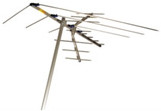Definition of Terms used by Engineers
"A",
"B",
"C",
"D",
"E",
"F",
"G",
"H",
"I",
"J",
"K",
"L",
"M",
"N",
"O",
"P",
"Q",
"R",
"S",
"T",
"U",
"V",
"W",
"X",
"Y",
"Z"
'Aa' to 'Ac', 'Ad' to 'Af', 'Ag' to 'Al', 'Am',
'An' to 'Ao', 'Ap' to 'As', 'At' to 'Az',
Adapter. A component that translates from one type of fixture to another. As in a connector that translates from an SMA to BNC connector. However there are adapters that mate to the same styles, as in BNC-to-BNC adapters. A device that couples two fiber optic connectors. |  DB Adapter |
A component which provides the necessary accommodations to electrically connect two or more items whose design or function will not normally permit their connection. An adapter may also provide mechanical connection. | |
ADB. The ADB or Apple Desktop Bus was a serial bus used by Apple computer to drive the mouse and keyboard interfaces. The cable consisted of one data line [ADB], a power line [+5v] and a ground line. The maximum data rate was 125kbps, actual bus speed was much lower. The ADB bus was rendered obsolete by the introduction of the Firewire interface on Apple Computer products.
Adder. A circuit that adds two or more numbers together. Also refer to an Analog Adder Circuit, or a TTL Digital Adder Block Diagram.
Address. The location of a component or terminal on a network. The location of a storage element within a memory chip. A set of numbers that use to uniquely identify something
Address Bus. The portion of an interface bus that carries the address of the node being selected. In most cases the address bus [A#] are pins separate from those that carry the data, but in some cases the address bus and data bus are time multiplexed on the same pins [AD#].
Address Field. The portion of a message that contains the source-user address and the destination-user addresses.
Adjustable Attenuator. A variable attenuator that allows the level of attenuation to be adjusted [common term in the RF field].
Adjustable Resistor. A resistor that may be changed in value by moving a wiper across its surface. Refer to the Dictionary of Resistor Terms.
Adjacent Channel. A frequency band immediately above or below a band of frequencies being used [as a channel]. Two or more analog communication paths spaced near each other.
Adjacent-channel Interference. The interference of one signal channel by another channel adjacent to it in frequency.
Adjacent Channel Separation. See Channel Separation.
Adjustment Pot. [Slang] A trimmer used to make a final circuit or component value adjustment. See the graphic to the right.
Adjustment Potentiometer. A Potentiometer used to make a circuit adjustment.
Admittance. [Y] The reciprocal of impedance, expressed in mhos [1/Z]. The sum of conductance [G] and susceptance [B], given as: Y = G + jB.
Aerial. An antenna. Refer to the Antenna Jargon Dictionary, which only relates to antennas.
Aerial Cable. A communications cable designed for installation on, or suspension from, a pole or other overhead structure. Dictionary of Antenna Terms.
AES/AES-256. Advanced Encryption Standard used by the US government.
AES/EBU. Audio Engineering Society/European Broadcasting Union. AES/EBU is one of the common names for a digital audio transfer standard. The standard is also known as XLR because the AES/EBU digital interface is usually implemented using 3-Pin XLR connectors, which happens to be the same type connector used in a professional microphone. One cable carries both left and right-channel audio data. AES/EBU is an alternative to the S/PDIF [Sony/Philips Digital Interface] standard. S/PDIF is a an audio transfer file format which uses an RCA connector.
Afterimage. A temporary or permanent condition of a display that results in an image left on the screen even though it is no longer being displayed. Image burn-in was always a problem with CRT displays as the phosphor applied to the back of the screens decayed. However, LCD screens also suffer from burn-in as the pixels degrade either from time or over-use. In both cases the ghost-image occurs when some pixel locations are used more than others, causing only those pixels to degrade [at a faster rate], which causes the ghost image. The after-effect of leaving a static display on a screen for some duration of time, with the static-image than becoming the ghost image as the display is changed.











